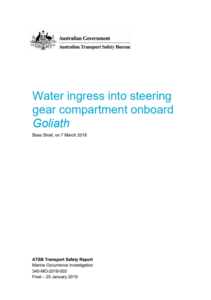ATSB presented its report regarding the water ingress into the steering gear compartment onboard Goliath, off Tasmania, in March 2018. According to the report, the request to close the after peak tank ballast line valves was not actioned as expected. This caused an undetected filling of the after peak tank during ballasting operations.
The incident
During operation of the ship, the second mate took over the watch and the ballasting operations, while the chief mate had completed hold inspections and rested, in order to attend training. The second mate attended training, and the third mate returned to the bridge at that time to take the watch.
[smlsubform prepend=”GET THE SAFETY4SEA IN YOUR INBOX!” showname=false emailtxt=”” emailholder=”Enter your email address” showsubmit=true submittxt=”Submit” jsthanks=false thankyou=”Thank you for subscribing to our mailing list”]
At 14.20, the ballast system was configured to complete the after peak tank water exchange. A little later the second mate returned to the bridge to take over the watch. However, the third mate retained the watch to complete the after peak tank ballasting which involved lowering the level to 8.5 m for ship stability reasons.
At 15.00, the third mate contacted the duty IR and asked that the two after peak manually operated valves be closed. For unknown reasons, the requested valve closures were not actioned. The third mate did not confirm with the IR that the message had been received and actioned so he was unaware that the valves connecting the after peak tank to the starboard ballast main had not been closed.
The watch was handed to the second mate who then continued with the next scheduled ballast movement of exchanging the water in the fore peak tank. He also did not know that the valves to/from the after peak tank remained open.
At 16.20, flow-through water exchange of port and starboard ballast tanks started. This involved the use of both ballast pumps and systems. At 17.30, the chief mate came onto the bridge and took over the watch.
Shortly after, an engine room alarm activated and the duty engineer responded. After entering the engine room, the first engineer saw water flowing over the doorstep through the open steering gear room door.
This water drained to the aft engine room bilge, activating the alarm. The first engineer discovered water coming from a scupper pipe in the steering gear room, which drained into the steering flat bilge well.
The bilge well was not fitted with an alarm and was manually drained to the engine room bilge. As a result, it had overflowed, leading to flooding of the deck to a depth of about 10 cm. The water then overflowed the doorstep, into the engine room, and to the aft bilge well.
Probable cause
According to ATSB, the following played a key role in the incident:
- The request to manually close the after peak tank ballast line valves was not confirmed or actioned as expected. This led to undetected filling of the after peak tank during subsequent ballasting operations;
- The after peak tank filled to a level sufficient for water to leak into the holed scupper line within the tank and drain into the steering gear room bilge well. This overflowed and flooded the steering gear room;
- There was no structured or formalised system of logging or tracking the status of ballast system manually operated valves. Thus, when closure of the after peak valves was not actioned or confirmed, there was no record at the ballast control panel to show the status of the valves.
Recommendations
The ATSB advised the following proactive safety action in response to this occurrence. Namely, CSL Australia took the following safety actions:
- Ballast tank inspection procedures have been reviewed and updated with added emphasis on internal tank fixtures;
- During scheduled drydocking of Goliath in 2018 it:fitted a ballast water treatment system in compliance with the Ballast Water Management convention which will remove the need for ballast water exchange;
- Had the ballast tank remote sounding and alarm system replaced;
- Had steelwork in the ballast tanks, including piping in the after peak tank, replaced.
For further details into the incident, click the following PDF































































